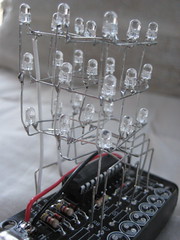The 3D LED grid has been around for a while. Early examples consisted of 3×3 grids of simple LEDs soldered together and displaying repeating patterns. This developed into larger and more complex arrangements, many of which became controllable in real time.
The list below is undoubtedly incomplete, and is also a slightly uncomfortable mix of artists and commercial enterprise. We would welcome references to any other significant grids and cubes that should be in this list – do please email us at mail (@) squidsoup.org.
I have also divided the LED grids and cubes that I am aware of into two sets – Object Cubes and Penetrables. Object Cubes are essentially cubes or 3D shapes made of lights that form a volumetric grid to be seen from an external viewpoint – they visualise objects within their own separate space. Penetrables (name inspired by Jésus Rafael Soto’s Pénétrables of the 60s and beyond) seek to create volumes and spaces that can be seen from within: walked through, experienced as an immersive boundless installation from the inside. This is a vitally important distinction to be made, as the aims of object cubes and penetrables are almost opposite – object versus environment, seen from within or without…

OBJECT CUBES
3 Way Labs – Cubatron (2004 – )
Probably the most famous of them all. The first version was a simple 9 x 9 grid with pre-programmed animation effects. This was followed by the Big Round and Quad versions.
James Clar – 3D Display Cube (2002 -)
An early adopter of the LED cube genre, Clar started working on them in 2002, eventually designing a modular and apparently infinitely expandable kit around 2008. The link also shows some excellent hand soldered early prototypes.
NOVA
A project by ETH Zurich, originally built to celebrate the 150th anniversary of the prestigious Swiss Federal Institute of Technology (ETH), and now managed by Horao GmbH. The main NOVA consists of 25,000 individually addressable points of light in a tight grid, 4cm diameter lights at 10cm pitch in a 50x50x10(high) grid. The system is made of 1m cubes consisting of 10x10x10 lights, of very high construction value.
ETHZ and Horao were kind enough to lend us (Squidsoup) a module for experiments in 2008 and 2009. We produced two projects on a mini-NOVA 1m cube – Stealth and Discontinuum – that were shown at numerous venues internationally.
rAndom International – Swarm Light and Future Self
Two 3D grid projects, both beautiful. The projects both attempt to translate natural movement (from swarms and a dancer) into the 3D LED spaces they create.
David Rokeby – Pixel Cube (2009)
Little information online about this, other than it is 12′ x 15′ x 18′ and consists of some 30,000 individually controllable LEDs. On permanent exhibition in Toronto.
Jim Campbell – Exploded Views (2011 – )
Campbell has made a couple of 3D grid projects recently, developing from his seminal XXX works of the early 00’s. Exploded Views uses reverse projection techniques to illuminate monochrome video exploded into an irregular 3D space. The ghostly imagery is only aligned from one sweetspot; from other vantage points it appears as abstract patterns. Exploded Views is on permanent show at SFMOMA. Also an interesting interview with Campbell here. A precursor to this was his project Scattered Light (2010)
Seekway
Chinese company that builds an ever increasing array of LED grids and cubes. AT time of writing, the highest resolution cube is 32*32*32 – that makes 32,768 individual points of light. From this video, it is clear that the increased resolution makes more realistic imagery possible. From the construction, Seekway see the future of LED cubes/grids to be as a display to be seen from outside.
PENETRABLES
Erwin Redl – Matrix 2 (2000-2005)
Undeniably beautiful – the aim according to the artist is in “(re-)translating the abstract aesthetic language of virtual reality and 3-D computer modelling back into an architectural environment”. See this release for more. The majority of Redl’s matrix series are flat, and do not vary over time. From the imagery, it appears that the repetitiveness of regular grids, and the moiré effect in the 3D one, is particularly strong in his work.
Muti Randolf – Deep Screen (2010)
Clearly aiming to create experiences seen from within – as he explains here.
UVA – Origin (2010)
UnitedVisualArtists have been leading the field with volumetric light installations for several years – Volume (2007) and Constellation (2008) were among several seminal examples of work exploring light, space, interaction and volumetric visualisations.
Jason Bruges – Pixel Cloud (2007)
Although not strictly “penetrable”, this 8 storey LED grid certainly could be if one could reach it.
Several projects explore the possibilities of 3D arrays of lights as a creative medium, capable of producing immersive and meaningful shared experiences.
SEE ALSO ( a few things related to LED grids but not directly…)
Matt Parker – Lumarca. A different approach projecting onto string
Second Story. Connected to a Microsoft Kinect.
Curosity – air suspended illuminated ping-pong balls (I think)
and electrocuted eyeballs, if you’ll do anything for that 3D effect…
